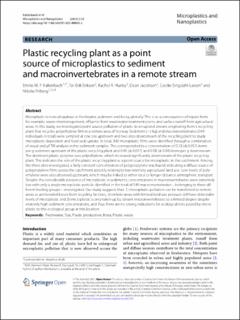| dc.contributor.author | Kallenbach, Emilie | |
| dc.contributor.author | Eriksen, Tor Erik | |
| dc.contributor.author | Hurley, Rachel | |
| dc.contributor.author | Jacobsen, Dean | |
| dc.contributor.author | Singdahl-Larsen, Cecilie | |
| dc.contributor.author | Friberg, Nikolai | |
| dc.date.accessioned | 2023-03-10T13:02:54Z | |
| dc.date.available | 2023-03-10T13:02:54Z | |
| dc.date.created | 2022-12-12T08:36:48Z | |
| dc.date.issued | 2022 | |
| dc.identifier.citation | Microplastics and Nanoplastics. 2022, 2, 26. | en_US |
| dc.identifier.issn | 2662-4966 | |
| dc.identifier.uri | https://hdl.handle.net/11250/3057729 | |
| dc.description.abstract | Microplastic is now ubiquitous in freshwater, sediment and biota, globally. This is as a consequence of inputs from, for example, waste mismanagement, effluents from wastewater treatment plants and surface runoff from agricultural areas. In this study, we investigated point source pollution of plastic to an upland stream, originating from a recycling plant that recycles polyethylene film in a remote area of Norway. Sediment (~2 kg) and macroinvertebrates (549 individuals in total) were sampled at one site upstream and two sites downstream of the recycling plant to study microplastic deposition and food web uptake. In total, 340 microplastic films were identified through a combination of visual and µFTIR analysis in the sediment samples. This corresponded to a concentration of 0.23 (± 0.057) items per g sediment upstream of the plastic recycling plant and 0.45 (± 0.017) and 0.58 (± 0.34) items per g downstream. The dominant plastic polymer was polyethylene, which increased significantly downstream of the plastic recycling plant. This indicates the role of the plastic recycling plant as a point source for microplastic in this catchment. Among the three sites investigated, a fairly constant concentration of polypropylene was found, indicating a diffuse source of polypropylene films across the catchment possibly relating to low-intensity agricultural land-use. Low levels of polyethylene were also observed upstream, which may be linked to either local or longer-distance atmospheric transport. Despite the considerable presence of microplastic in sediments, concentrations in macroinvertebrates were extremely low with only a single microplastic particle identified in the total of 549 macroinvertebrates—belonging to three different feeding groups—investigated. Our study suggests that: 1) microplastic pollution can be transferred to remote areas as unintended losses from recycling facilities, 2) remote areas with limited land-use pressure still have detectable levels of microplastic and 3) microplastic is only taken up by stream macroinvertebrates to a limited degree despite relatively high sediment concentrations, and thus there are no strong indications for ecological risks posed by microplastic to this ecological group at this location. | en_US |
| dc.language.iso | eng | en_US |
| dc.publisher | Springer | en_US |
| dc.rights | Navngivelse 4.0 Internasjonal | * |
| dc.rights.uri | http://creativecommons.org/licenses/by/4.0/deed.no | * |
| dc.title | Plastic recycling plant as a point source of microplastics to sediment and macroinvertebrates in a remote stream | en_US |
| dc.title.alternative | Plastic recycling plant as a point source of microplastics to sediment and macroinvertebrates in a remote stream | en_US |
| dc.type | Journal article | en_US |
| dc.type | Peer reviewed | en_US |
| dc.description.version | publishedVersion | en_US |
| dc.source.pagenumber | 15 | en_US |
| dc.source.volume | 2 | en_US |
| dc.source.journal | Microplastics and Nanoplastics | en_US |
| dc.identifier.doi | 10.1186/s43591-022-00045-z | |
| dc.identifier.cristin | 2091691 | |
| dc.source.articlenumber | 26 | en_US |
| cristin.ispublished | true | |
| cristin.fulltext | original | |
| cristin.qualitycode | 1 | |

